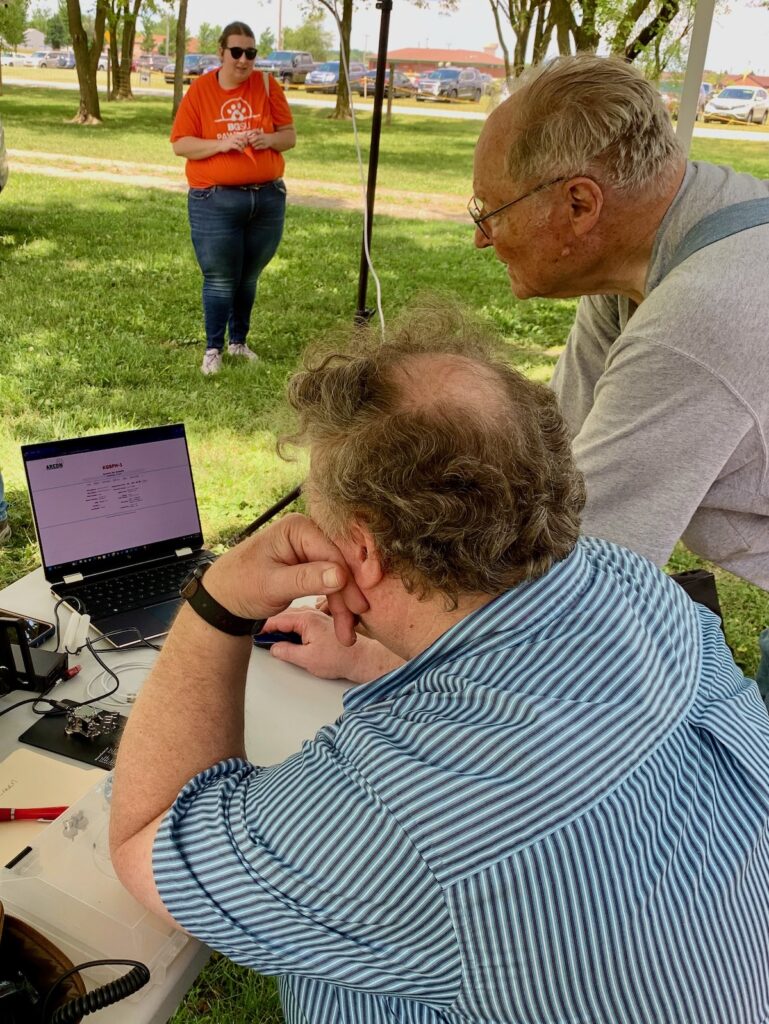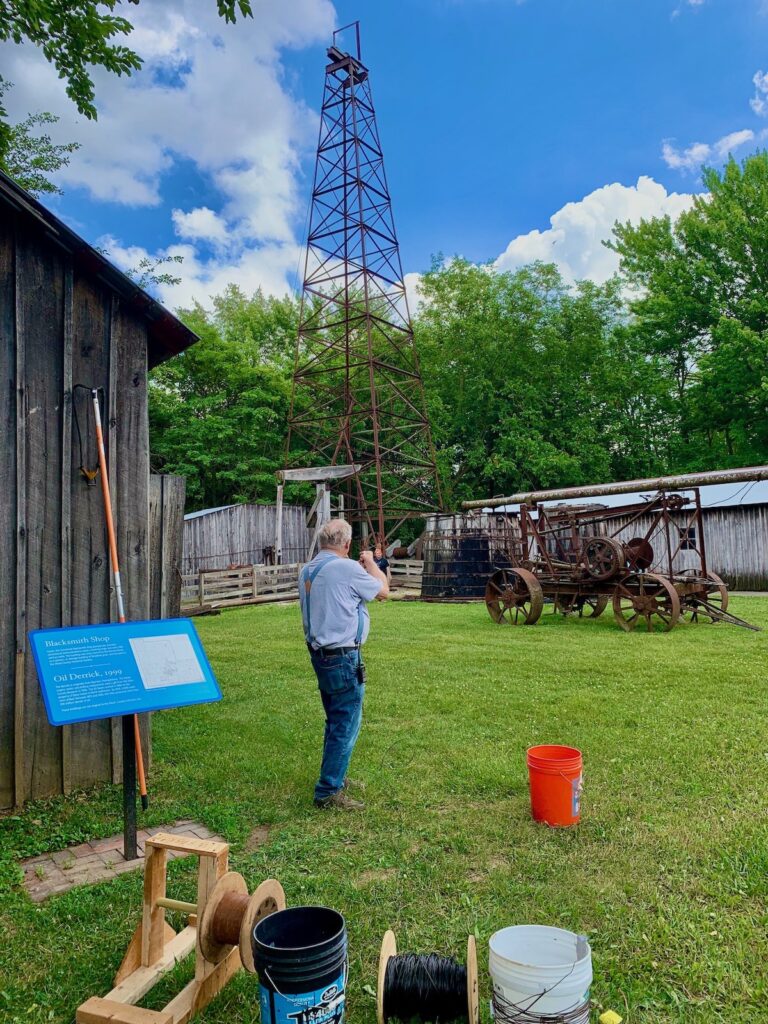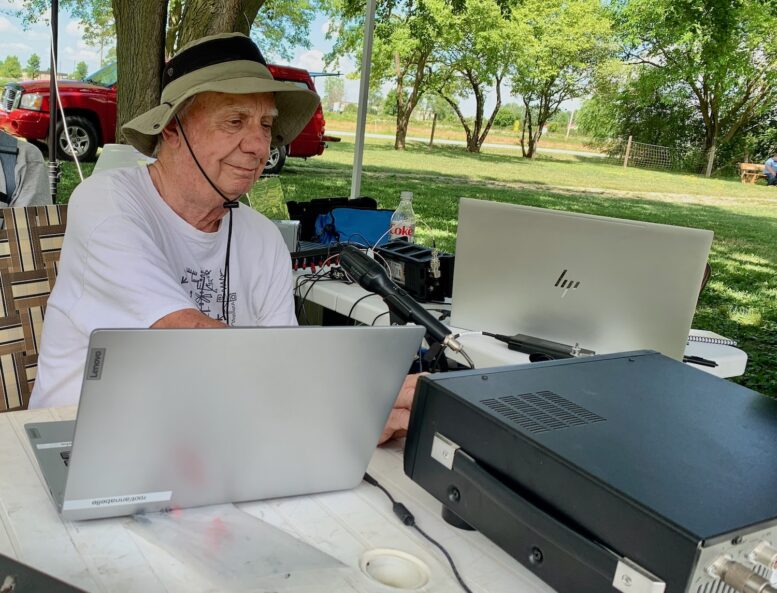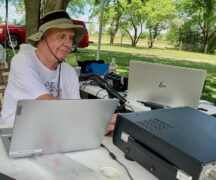By JULIE CARLE
BG Independent News
“Kilo Eight Tango India Hotel” was repeated hundreds of times over the weekend when the Wood County Amateur Radio Club participated in the American Radio Relay League (ARRL) Field Day. Members of the club set up temporary transmitting stations for K8TIH near the Wood County Museum to connect with other hams.
K8TIH or “Kilo Eight Tango India Hotel” represents the call sign for the local club. The words which correspond to the letters in the call sign are the language they use to clearly identify themselves when connecting to other ham radio operators, or “hams,” around the globe.
Wood County’s club, like many across North America, used the 24-hour field day to practice emergency preparedness, spend time and connect with like-minded ham radio hobbyists.
According to ARRL, an estimated 40,000 individuals participated in the drill to demonstrate how the hobby combines public service, emergency preparedness, community outreach and technical skills.
Amateur radios are not to be confused with CB radios, said Jeff Halsey, club president and a music professor at Bowling Green State University. He described the hobby as a technical specialization that involves tools such as Morse code, microphones, phones, antennas, open repeaters and digital media. They use the radio frequency spectrum for non-commercial messages, wireless experimentation, self-training, private recreation and emergency communications.

Amateur radios are known to be able to communicate when other means are lost.
When storms or other disasters damage critical infrastructure such as cell towers and wired and wireless networks, ham radio operators can communicate without the use of the internet and phone systems. They raise a wire antenna in a tree or on a mast, connect it to a radio and a power source and communicate with others.
“We do this field day to simulate an emergency situation such as a tornado or hurricane,” Halsey said. “When communities lose power, we can still communicate. We set up in the field to show how we can provide reliable communication.”
Throughout the 24-hour field day, club members focused on contacting as many amateur radio operators as possible all over the country. Though the exercise was also a contest where clubs earned points for successfully completing various tasks from the number of contacts to getting media coverage, the Wood County club’s main goal was to make sure they are ready to help the county during any communications crisis.
Set-up is a critical component, said Bob Willman, who earned his amateur radio license in 1971 and has held various officer positions in the club. In addition to placing the all-important generator in a safe location for power, they string wires and antennas in the locations for premium reception, though weather and objects such as trees and buildings can become barriers.
At the museum location, they used a pulley system to snake cables through the top of the old oil derrick and then wound them through the treetops, in an elaborate network.

Once the stations were set up, club member Bob Boughton, a retired BGSU physics and astronomy professor, was seated in front of the 100-watt radio, tuning the dials, listening to and sharing the club’s call sign with other hams from locales such as Texas, Colorado and Florida, and logging the communications.
With this year’s field day, the Wood County club was thinking ahead to next year’s total eclipse on April 8. According to Eric Willman, a club member who is also the Wood County emergency coordinator for the Amateur Radio Emergency Service (ARES),“We wanted to make sure we are ready for whatever the eclipse situation might bring.”
With the path of totality cutting a wide swath through Ohio including Bowling Green, he said state officials are concerned about potential gridlock, depending on where people choose to be for the early afternoon solar event. “Weather could play a part,” Willman continued, “but we may not know what to expect until closer to the eclipse.”
They want to be prepared to avoid situations like what Kentucky experienced during the 2017 eclipse. The number of people who traveled to Kentucky from across the globe to observe the eclipse depleted supplies and created huge bottlenecks. “The roads were jammed. Gas stations ran out of fuel, and grocery stores sold out of food,” Willman said.
That is one scenario where amateur radio operators could help, he said. There may not be a power loss, like during a natural disaster, but hams can provide essential communication resources when law enforcement and emergency management staff are involved in people and traffic management.
Amateur radio operators work side-by-side with the police, sheriff, fire officials, emergency management and hospitals, Willman said. For natural disasters similar to the Lake Township tornado in 2010, the first 72 hours follow Federal Emergency Management Agency protocols and then health and welfare are handled locally.
Hams may be tasked with sending radiograms,” similar to telegrams, that share information about the welfare of individuals to concerned family members.
“We have a lot of support in the county,” said Willman, who also takes care of the sheriff’s radios. Quite a few county officials are also amateur radio operators and understand the value they bring to the community. The county purchased a small trailer with many of the essential supplies for emergencies that can be transported to wherever it is needed.
“We help make the county communication infrastructure stronger,” he said.


